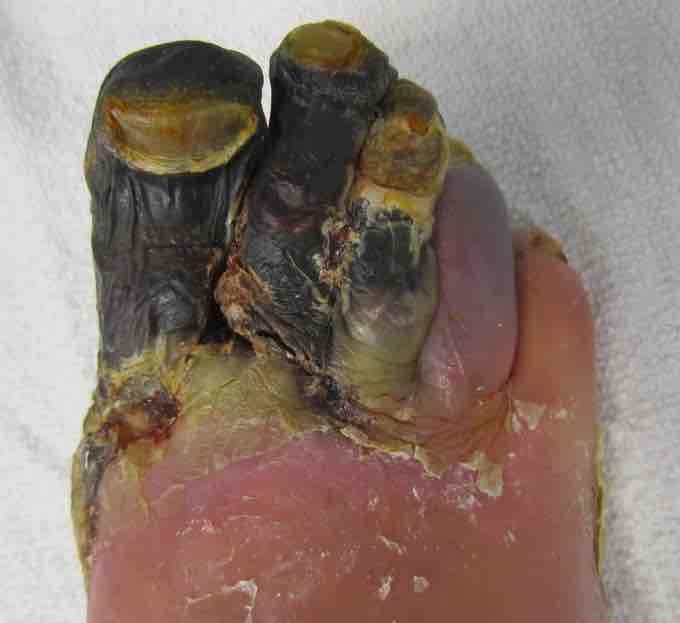Gangrene is a serious and potentially life-threatening condition that arises when a considerable mass of body tissue dies. This may occur after an injury or infection, or in people suffering from chronic health problems affecting blood circulation. The primary cause of gangrene is reduced blood supply to the affected tissues, which results in necrosis, or cell death. Diabetes and long-term smoking increase the risk of suffering from gangrene.
There are different types of gangrene with different symptoms, including:
- Dry gangrene begins at the distal part of a limb due to ischemia (restriction of circulation), and often occurs in the toes and feet of elderly patients due to arteriosclerosis (hardening of the arteries). Dry gangrene spreads slowly until it reaches the point where the blood supply is adequate to keep tissue viable. The affected part is dry, shrunken, and dark reddish-black, resembling mummified flesh. The gangrenous tissue most often detaches spontaneously .
- Wet gangrene occurs in naturally moist tissue and organs such as the mouth, bowel, lungs, cervix, and vulva. Bedsores occurring on body parts such as the sacrum, buttocks, and heels are also categorized as wet gangrene infections. In wet gangrene, the tissue is infected by microorganisms that cause decay, in turn causing tissue to swell and emit a fetid smell. Wet gangrene usually develops rapidly due to blockage of blood flow, most commonly in veins. The affected part is saturated with stagnant blood, which promotes the rapid growth of bacteria. The toxic products formed by bacteria are absorbed, causing systemic manifestation of septicemia and finally death.
- Gas gangrene is a bacterial infection that produces gas within tissues. It is a deadly form of gangrene usually caused by Clostridium perfringens bacteria. Infection spreads rapidly as the gases produced by bacteria expand and infiltrate nearby healthy tissue. Because of its ability to quickly spread to surrounding tissues, gas gangrene should be treated as a medical emergency.
- Necrotizing fasciitis affects the deeper layers of the skin.
- Noma is a gangrene of the face.
- Fournier gangrene usually affects the male genitals and groin.
Treatment of gangrene is usually surgical debridement, wound care, and antibiotic therapy, though amputation is necessary in many cases.

Dry Gangrene
Gangrene of the 1st to 4th toes of the right foot of a person with diabetes.